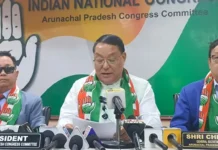[Dr. Nabam Budh]
World Blood Donor Day is celebrated in every country around the world to commemorate the altruistic voluntary blood donors whose only intention is to save lives and to help the helpless. India too celebrates the Day since 2004, the inception of the event.
On this Day, I would like to share few facts about blood science and blood donation.
Blood is constituted of two portions, viz, fluid portion and formed element. Formed part is again comprised of red blood cells, white blood cells, platelets and many types of protein, hormones, immunoglobins etc. Redness of blood is due to presence of haemoglobin in red blood cells.
Function of blood cells: to simplify- red cells carry oxygen and nutrients to different body cells at different body parts for their respiration and survival, and carry back metabolic waste from cells to elimination portal through GIT and urinary systems. White blood cells have again two main types, viz, neutrophils and lymphocytes. Neutrophils defend us from acute infections and lymphocytes generate army of antibodies and immunoglobins, called immune system, which defend us from pathogens (bacteria, virus, parasite & fungi) and also eliminate abnormal cells, including some cancerous cells, from body etc. These cells have specific life span, viz, red cells die out in 100 to 120 days, white cells die out at 15 days, platelets die out within 5 days in healthy state. But, cells life span dramatically reduced in bad health or infections period; die out in course of fighting intruders. However, these cells are continuously produced in the body by bone marrow (white jelly material inside bone) in regular phage according to need of body.
Our body has inherent regulatory mechanism which regulates demand and supply system in body. Meaning thereby, when blood cells are enough, manufacturing units of these cells are in dormant state but only to replace dying out portion, about 120 ml every day and expedite manufacturing units when blood volume or cells quantity is less.
We human beings have blood at the rate of 66 ml/KG body weight in females and 76 ml/KG body weight in males. We have 4.5 litres to 5.5 litres (Average) of blood, depending on our body weight. However, for our requirement for survival and comfortable living, we need 50 ml/KG body weight only. In this sense, we have 1.5 litres to 2.0 litres of blood that remain extra in body, perhaps, God has given is portion for tackling emergency situation. However, medical science has so developed, that a human being can share this extra portion to save or help another life. It’s a great gift of God or nature.
In blood donation, we withdraw only 300 ml in 350 ml blood bag type and 380 ml in 450 bag type. Nevertheless, extra blood in body is not completely withdrawn. Presently we are using 350 ml bags as average body weight of donors are 55 KG to 60 Kgs compared to others in mainland and other countries.
What happens in blood donation?
As soon as bone marrow receives signal of blood being withdrawn or letting out marrow, it starts producing blood cells to fulfil the deficit. The fluid portion is replaced within 24 hours after blood donation from the food and beverages we intake, red cell is replaced within 22 to 25 days and white cells within 15 days. After blood withdrawn, together with red cells white cells are also produced in large quantity. These cells are young and energetic to carry oxygen efficiently in case of red cells and defend us effectively in case of white cells. Not only saving lives and helping others, the blood donation itself seems to be an act of producing health within oneself.
We have witnessed that after blood donation donors gain more haemoglobin level, even if, his/her haemoglobin was lesser and gain robust health.
If anyone is found not fit for donation, he or she is deferred. It doesn’t mean debarred from blood donation. Deferred, meaning he or she is not fit to donate at that time. There is so many advantages in blood donation, such as, history taking from potential donors (regarding life style, food habits, health etc), health check up, blood testing for infectious diseases, haemoglobin level check, especially for female donors, opportunity to talk to checking doctors and meeting good people.
If anyone is found not in good health, say, high blood pressure or palpitation, he/she is advised or referred to appropriate doctors. If blood is found infectious, while testing, he/she is confidentially informed to see appropriate doctors to get early treatment. So, save for the fear of needle prick, which is only 30 % of muscular injection pain of prick, and there are numerous advantages.
Why we should not donate blood? It is a lingering question. Even if one doesn’t donate blood, blood cells die and waste out daily. Why should we not share the same to help someone?
On behalf of department of health & family welfare, GoAP, I do express heartiest gratitude to all those unsung heroes who donated their precious gift of God selflessly and saved thousands of lives in Arunachal Pradesh every year. (The writer is Consultant Pathologist-cumDeputy Director SBTC, Nodal officer (Diagnostic Service), Directorate of Health ServicesState Nodal Officer (State Blood Cell), NHM)





